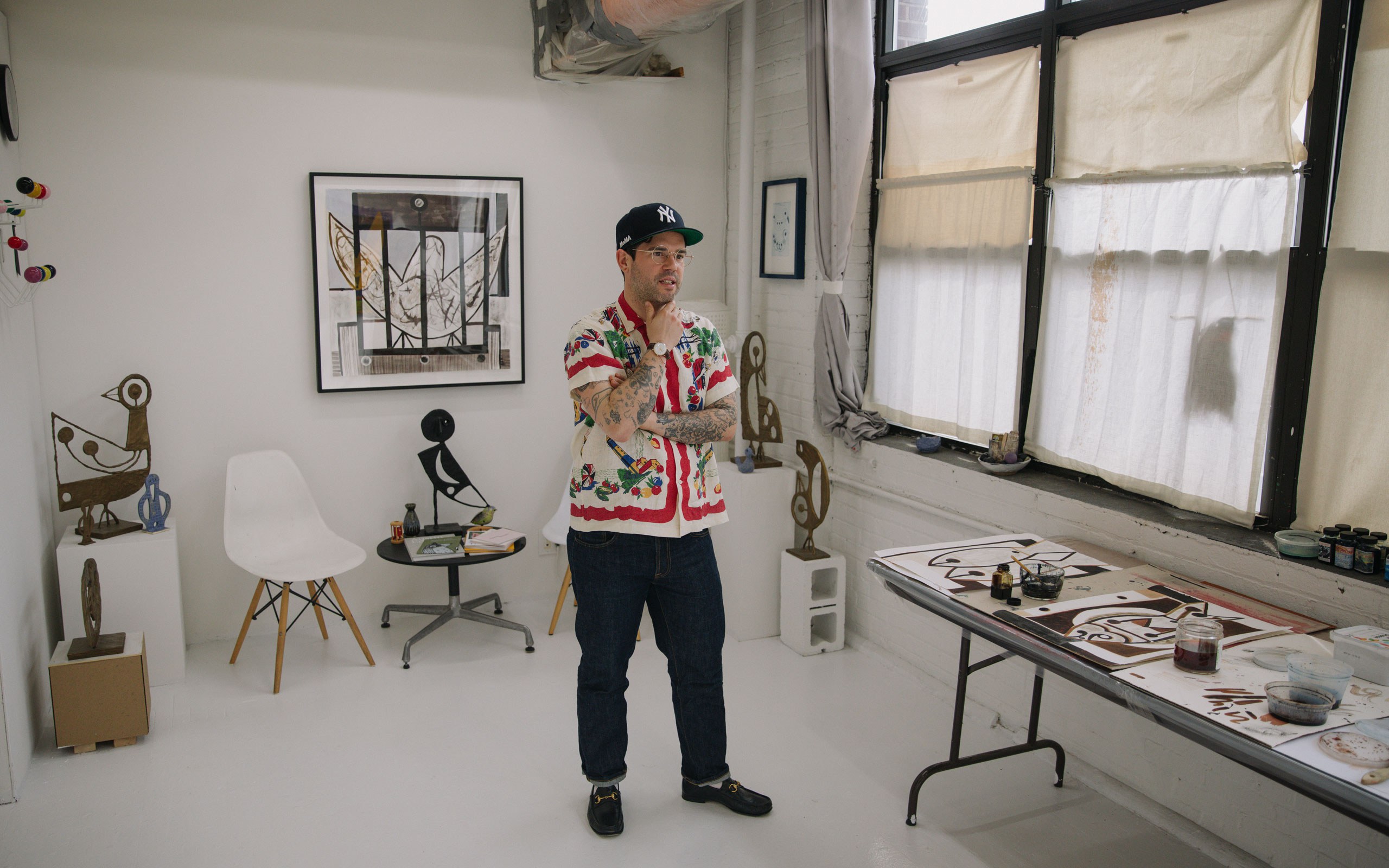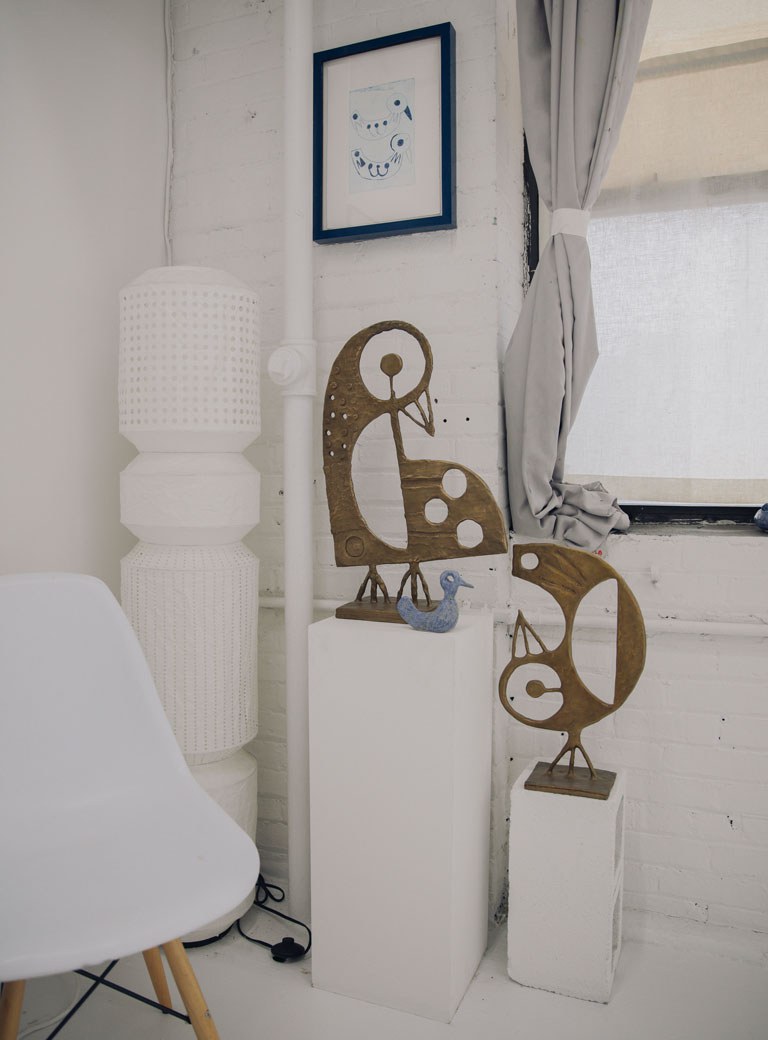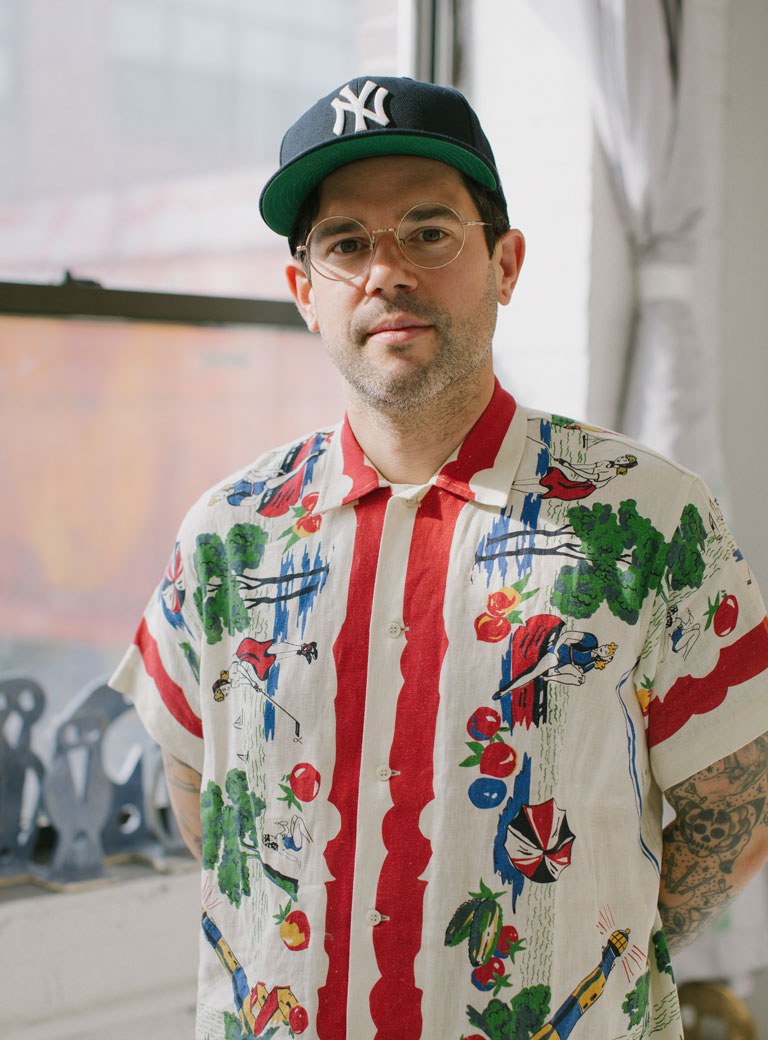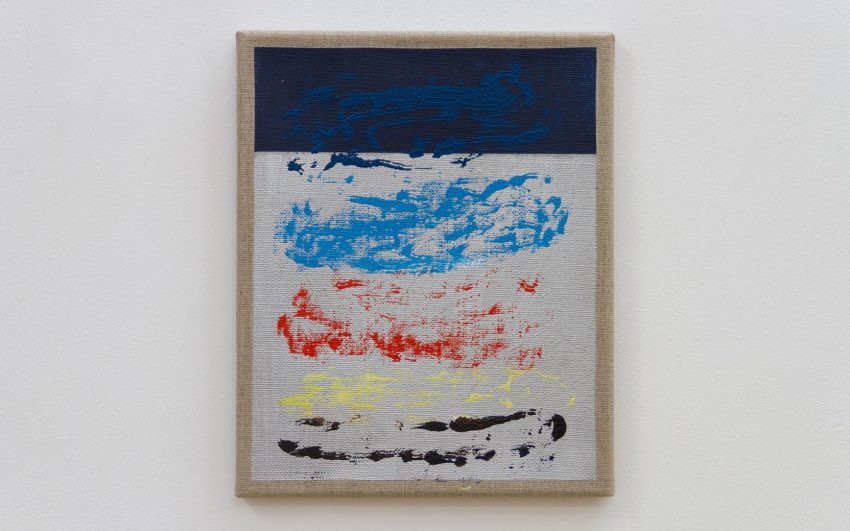Brooklyn-based Austin Eddy’s paintings call on the viewer to create their own stories out of the ones he proposes. He might use autobiographical events and abstract them to birds, but never imposes his own interpretation. His birds are more form than animal: they are stand-ins for the very human desire for personal freedom, framed by its equally strong wish for stability and structure. As his work toes the line between figurative and abstract, it recalls the cubist forms of the 20th century, while being firmly anchored in Austin’s present.
Austin, how did you get into painting?
Initially, I started doing lots of drawings as a child, cartoons and comic strips. Later on, I did graffiti which lead to a more serious interest in more traditional art. That phase of my life stopped though, when I decided to go to art school. At the School of the Art Institute of Chicago I chose to primarily focus on fine art.
What did your work look like at the beginning?
Initially I was focused on black and white figure painting, but how this was working out became too redundant for me. The narrative is always at the forefront, and I did not find that very rewarding. For example: when you have a picture of a person in a bar, it is pretty clear what that entails. But if you change the person to a bird and the bar to a tree, it abstracts the potential of the narrative. I was keen on telling a story but allowing room for the story itself to unfold, opening up its characters, making space for opening up meanings.
So when did you stop doing figurative work then?
That happened in or around 2015. From there I was exploring abstraction and thinking about stacking forms in tandem with removing the figure. Having this new lexicon of icons be the characters in the stories I was trying to tell. That transition ended up with me moving more towards bird forms by way of boats. I started painting the bird form more clearly in 2018.


Is the bird a metaphor for freedom?
Well, at times. But it’s equally a symbol of something that is trapped or caged. I am thinking about the duality of existence: the longing for freedom but at the same time a need for structure. Be it a family, job, self-imposed rules etc. This same appreciation for duality can be applied to the trees the birds are sitting on: they are meant to be a solid space, something secure but simultaneously a very vulnerable space. A tree is rooted, but is subject to move with the wind in a storm… like us through points of difficulty and conflict.
Are the birds really birds or something else entirely?
The birds here are more of stand-ins for characters, for parts of our emotional being. It’s the viewers interpretation that matters. Basically, the shapes of the birds are the foundation of the whole thing. The way the forms interact creates tensions and narratives of their own. In addition, how the paint edge meets other parts of the painting creates its own anxiety or harmony.
I wonder whether you ever get to watch birds – it seems impossible knowing that you live in New York City… Are there even any birds at all?
We have a lot of birds! For instance, we have cardinals and blue jays in our backyard, there are morning doves, crows, even a hawk in the park near us, and there was an owl in a tree last year. You know, New York is a corridor for migration.




Austin Eddy, A Home Of One’s Own., 2023, Oil and Flashe on canvas, 45.5 x 40.5 cm / 18 x 16 in, EDDY59391, Courtesy the artist and Galerie Eva Presenhuber, Zurich / Vienna, © the artist, Photo: Stan Narten, JSP ART PHOTOGRAPHY
Birds, trees, and flowers not only appear in your work, but are central to an art form that seems to be close to your heart: Folk Art. Is it an influence?
It is one of the more influential forms of art that I am looking at. There is so much honesty and vulnerability, a directness in the way these artists work… It is something that I feel is very important… There are some historical European Folk artists that I do look at – more in line with the Art Brut Movement. Artists like Carlo Zinelli, Adolf Wölfli or Alessandra Michelangelo. I am also very interested in contemporary Folk artists in America like Eddie Arning, Mose Tolliver, or Sylvia Fragoso.
Is there a high-low divide though, do you feel that people might dismiss Folk Art as not being “serious” art?
I think people who aren’t interested in that will be disinterested in everything. It’s like looking at a Jackson Pollock painting and saying: “My kid could do that”. There is no difference saying the same about Folk Art.
No divide for you then?
No, there is a lot of ingenuity and expression that goes into these works…
Well, one could say that this is exactly what attracts people to your own paintings as well!
I think I do try to make them as unintimidating as possible.
Which means that the viewer doesn’t necessarily have to have a background in art history to feel comfortable with your work…
Exactly! Because that is my biggest fear: having to read six press releases in order to understand one painting! I just want my paintings to be paintings for everyone.


Apart from Folk Art, do you look at other art traditions at all?
I look at a lot of traditions, be it design, textiles, tourist trinkets or historical and contemporary work… Looking at other artists in history can feel less inspiring than informative, I guess. Knowing where we were is helpful when wanting to know where we can go. The history of painting is a great place to start; I’m asking myself: “How can I find a crack to move forward?”
Is it a struggle to find that crack, to affirm yourself in art history?
It’s an interesting challenge. It gives you a reason to keep going; if it was easy, it wouldn’t be fun. I think my paintings are rooted in history, but they are also invested in the potential of adding to it.
How do you start a painting? What kind of references or inspirations do you use?
There are many points of departure for my work. They are somewhat all interchangeable as well. For instance a drawing can inspire a painting, or a painting a sculpture, and a sculpture a print. I try to keep my practice able to reinvigorate itself to remain sustainable. As for the external sources of inspiration it can be almost anything. For example in this show, my wedding was a starting point, or a chicken in a tree down in Key west, or something more art historical like Klimt’s Kiss… The beginning is not always art history, but maybe a personal history than can get abstracted through the process of remembering.
And then it is on to preparatory drawings?
I often start with drawings, mostly with smaller, monochrome works. They are not preparatory works as I see them as finished objects at the end. These drawings are often made using colored pencil or ink washes, a way to figure out the formal arrangements. They are more like a dance. How the forms meet in the drawings can be decided to allow room for the colors to harmonize in a painting. In the end it is not all necessarily predetermined, but the way they occupy the space is solid. Fewer distracted decisions allow for more poetic decisions in a way.
Do you put up any photographs as references while you are painting?
No, in my studio there is very little. I try to keep it as an empty room, paint and tables and chairs. I don’t have any of my finished works up in my painting studio. Nor do I have any source material, I’m relying on memories and thoughts to build the paintings. But on the other side of the wall, there are some sculptures, and in my storage area, you will find postcards, posters and books.
So you don’t want your inspiration sources close while you work?
In a way that is true. I feel there is a distortion when remembering something, thus allowing for some awkwardness. My memory of Klimt’s Kiss is very different than looking at the photograph of it. There are a lot of oddities in how things get reinterpreted. For instance, I might have seen the pattern on a quilt six years ago and then suddenly start to think about it again; the time elapsed allows for omission of parts of that quilt that weren’t important to me. But if I would be looking at photographs of that quilt, those parts would become important again. I don’t want everything. I want the memory of these more interesting or significant parts to become real to me.



Your show Songs For The Sun is currently being presented by Galerie Eva Presenhuber in Vienna. Let’s look at the paintings, there is this brightly colored canvas that immediately grabs one’s attention…
It is called The Wedding – and as I mentioned, it was inspired by my own wedding! The work itself can be seen referencing geometric abstraction from the 1960s, but it also captures that spirit and excitement of a wedding. Really trying to portray the anxiety and energy of that kind of evening. The birds here look like they are on the dance floor – or on a quilt in the park at a picnic. Things can be many things at once I guess.
Your work does not actually transport anxiety to me…
This is precisely what I am trying to achieve and what I think can be the most important part of a painting: my narrative should be lost, and it is now the job of the viewer to complete the circle.
The viewer should therefore not read a specific story into your paintings?
No, I would hope not. Here my goal is to create a space for you. My paintings are not necessarily windows into my reality, but more of a mirror into yours. I want them to be a place for reflection, for your thoughts to take form.
In some of your paintings, you combine different perspectives – a flat one or birds eye view… Why is that?
The painting becomes a space that folds onto itself, a bit like in the movie Inception. This folding of space complicates the environment. You can’t really paint all the perspectives! I mean, artists have tried this with Cubism… But with my paintings, you are asked into this flat space and it folds over as you read the image and see a change in perspective within the painting.
Galerie Eva Presenhuber is also showing some smaller, monochrome paintings of yours, like A Home Of One’s Own. I wonder how you choose your canvas sizes?
Size is not really relevant; the painting needs what it needs. A small painting can function just as well as a large one if it is done with the right intentions. Sometimes I like the small paintings more than the larger ones.
However, don’t you think that a larger painting might be easier to understand for the viewer?
That might be, but the small paintings are often much more direct, there is less room to hide in them. The process is very visible in the smaller works. It’s like a drawing… Actually, I think drawings are the most honest part of an artist’s production. There is no hiding, whereas paintings can be hidden in color or process.
Would you say that you are more truthful in your smaller paintings?
Maybe so… but I try to keep that honesty in the larger works too. I don’t do a lot of rearranging, and I stack the colors in a way that allows you to see the layers. I am trying to show the history in my paintings.

Installation view, Austin Eddy, Songs For The Sun., Galerie Eva Presenhuber, Vienna, 2024, © Jean-Marie Appriou, Andrew Lord, Courtesy the artist and Galerie Eva Presenhuber, Zurich / Vienna, Photo: Jorit Aust

Austin Eddy, The Wedding.,2023, Oil and Flashe on canvas, 203 x 142 cm / 80 x 56 in, EDDY59386, Courtesy the artist and Galerie Eva Presenhuber, Zurich / Vienna, © the artist, Photo: Stan Narten, JSP ART PHOTOGRAPHY

Installation view, Austin Eddy, Songs For The Sun., Galerie Eva Presenhuber, Vienna, 2024, © Jean-Marie Appriou, Andrew Lord, Courtesy the artist and Galerie Eva Presenhuber, Zurich / Vienna, Photo: Jorit Aust

Installation view, Austin Eddy, Songs For The Sun., Galerie Eva Presenhuber, Vienna, 2024, © Jean-Marie Appriou, Andrew Lord, Courtesy the artist and Galerie Eva Presenhuber, Zurich / Vienna, Photo: Jorit Aust
Looking at the stacking of colors, as you call it: you apply the paint on the canvas in layers that vary in thickness?
Sometimes the thicker parts reuse all the colors that have been mixed together for a painting. It is like a deposit of remembrance for all the parts that have been used. For instance, looking closer, the viewer can see that a bird at one time was green, then turned to brown, then orange and is now a pale pink… Somewhere there is grey color which might be called on to sing underneath a more yellowish hue, this makes the yellow feel different. There is some interest in color theory while I am making the paintings – or at least I am trying to understand my interest and investigation of the poetics of color.
When do you know a painting is finished?
The painting might tell you. But at other times, you might have to stop prematurely because there is the potential of overworking it. Also, you could finish a painting to full resolve, but then there would be no vulnerability left in it… And I think vulnerability in painting is its most interesting aspect. This is why I try to keep my work as vulnerable and open as possible. Eventually, it’s about feeling aware that the work is finished, but still knowing that there is something that could be changed. Because: if every painting was done perfectly, why make a new one at all?
So if you ever did a perfect one, would that be the end of your career?
You always wonder what the next step could be. Using a formula feels very uninteresting to me. Figuring it out and growing are the exciting parts! And the viewer having the final say is the key part. I have a story, but making room for your story is more important.
Consequently, there is no ego in your work?
I try not to put it in. If my art was just about me, I would be an actor or something like this! Being a painter means I don’t have to be there. Of course, I think I am still present in the work, but it is not about me. It’s rather about me opening up with a story, possibly my story, and the viewer establishing their own relationship and story because of it. It’s about looking for truth and making friends, vulnerability creates stronger relationships.
Your work isn’t autobiographical then? Even though you reference your wedding, for instance?
It’s a disconnect, because as you say, they are autobiographical in a way. However, that aspect is just the starting point and not the end goal. My narrative becomes our shared narrative because the viewers story fills in the void. I guess with these works, where I end is the beginning.
Because of the colors and shapes you use, your pictures seem joyful at first sight. However, you sneak in a bit of heaviness too?
Yes, this is the beginning of it all: the acceptance that joy and grief coexist. Just because you are happy in a certain moment does not mean that this happiness isn’t tinged with sadness. And in reverse, even something somber might feel joyful later; it’s all about perspective. You might get hurt, stub your toe for instance, but you won’t remember it later. With the paintings, I try to be that open. Initially I start out with a somber painting, but through the process I will end up with a more joyful feeling one. They come full circle in a way.
And therefore they are open to any mood the viewer might be in?
Right. You can come back in two years, look at the same work and feel something different. It’s like an abstract painting – since there is no central narrative or subject, it’s open to interpretation. More like a poem, really.

Talking about poems – do you write yourself?
Not really, not for the world. But I read a lot of poetry, and some of my titles are references to those texts. For instance, for this show I have used a quote from Cyrano de Bergerac that was quoted by Paul Verlaine at the start of one of his poems about a nightingale in a tree fearful about drowning while perched on a branch.
This probably means that you are an avid reader?
Yes I try to be! Not only of 17th century literature of course, I’m trying to get it all in. It’s like looking at art galleries and art history! I am reading historical literature, contemporary literature and anything in between. The biggest part of living is learning and trying to experience the most you can.
Do you feel that you need to be literate in literature or music, not just in history of art?
I think so. You can get overwhelmed with “just” art and you might need an escape. Listening to music or reading a book provides one. These outlets allow you to experience things differently. A song can change how you view a painting! I am very much interested in moods and time and how these things can coexist.
You are not only a painter and draughtsman, but a sculptor too. For instance, in your bronze City Bird (2023), a bird is standing on a house; the house made me think of Louise Bourgois, the bird of Max Ernst… Does it bother you that people make these kinds of connections when they look at your work?
I don’t think it is annoying as much as it is human. I think we often need the crutch of a reference point to get to something. Today, anything new will always be relatable to something else in the past.
Talking about new – what are your future projects?
I have been working on a series of new works with a new process for an upcoming exhibition. I was invited to work at the shop at Pace Prints on a group of hybrid “monotype” / paper pulp drawings. Some of them are also collages and more traditional hand embellished drawings. These works will be exhibited in New York in February 2024. I have also been experimenting with ceramics and will be exhibiting some of those in the near future as well. But the big push right now will be for a show at the Kunstverein Heilbronn in fall 2024. Here there will be not only a shift in scale (larger paintings), but also in subject matter. There will be new things on the horizon which is equally daunting and exciting.
Interview: Alexandra Markl
Photos: Katharina Poblotzki






